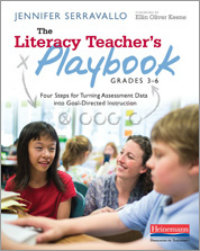Using Classroom Assessment Data to Target Instruction
The Literacy Teacher’s Playbook, Grades 3-6: Four Steps for Turning Assessment Data into Goal-Directed Instruction
By Jennifer Serravallo
(Heinemann, 2013 – Learn more)

Data driven instruction is a term that makes many teachers cringe because “data” is so often associated with the numbers and statistics seen in achievement test results. However, data driven instruction is about more than achievement test results.
As Jennifer Serravallo makes clear in her recent book, data driven instruction involves using collected data from many sources (observed, verbal, or written) to help design and plan lessons around students’ needs.

The Literacy Teacher’s Playbook is composed of four chapters, growing out of Serravallo’s four-step protocol for literacy and language arts data driven instruction: (1) collect data; (2) analyze data; (3) interpret data and establish a goal; and (4) create an action plan. Using this protocol, she coaches readers through each step with examples and templates that demonstrate how to do each step.
Broader applications
Even though this book says a lot about ELA topics, the literacy-writing connections make it a useful text for other subject areas and special education teachers as well. Since most states have adopted the Common Core Standards, each subject area is expected to emphasize reading and writing in the content area — an expectation that makes many subject-oriented teachers uncomfortable. They will find some real help in this book, as they learn strategies to analyze students’ writing and discover what else needs to be taught, strengthened, or remediated.
Both special education teachers and general teachers will find great examples of how to differentiate instruction to meet the needs of students. Serravallo explains how data driven instruction can help identify students’ strengths and weaknesses so that teachers can target instruction to student needs.
As a college instructor, I believe this book has potential to be a powerful tool for assessment classes because it provides aspiring teachers with data to help them learn how collect, analyze, interpret and establish goals — and create an action plan without having a classroom of their own.
My only complaint about the book is the appendix. It lacks some templates that Serravallo used in her chapters and that many teachers would like to reproduce for use in their classrooms. She does provide six templates (and a website where you can download the same six templates), but the others are not included. I believe it would be more useful to include all of the book’s templates and examples so that teachers can have them at hand.
Casey Gilewski is from Memphis TN and is currently a doctoral student and graduate teaching assistant. She has taught in public schools for six years – one year in second grade and five years across grades 6-8. Throughout her public school experience, she has taught English language arts and special education and has served as grade chair and on Common Core committees. Her doctoral dissertation focuses on differentiated instruction and assessment.






























